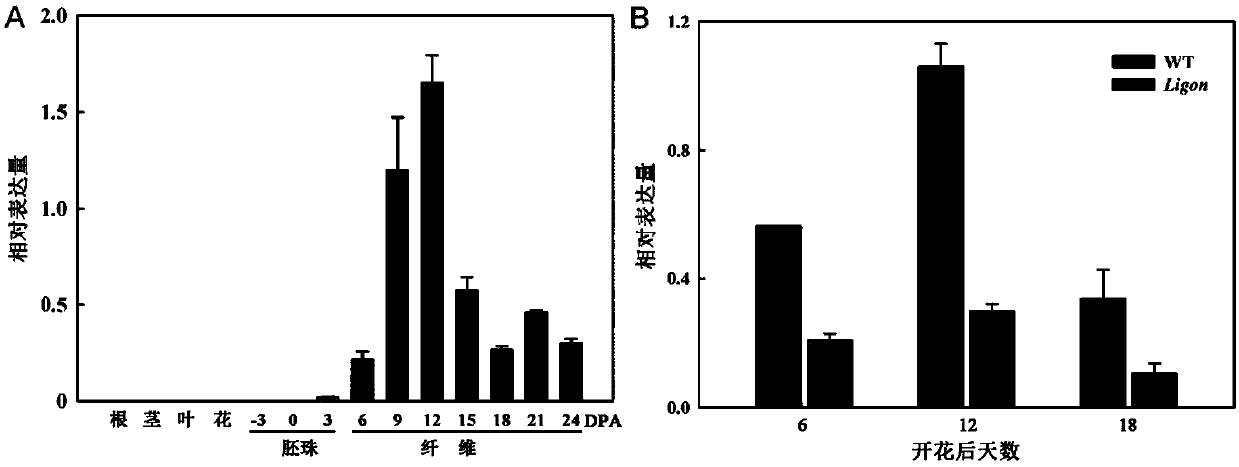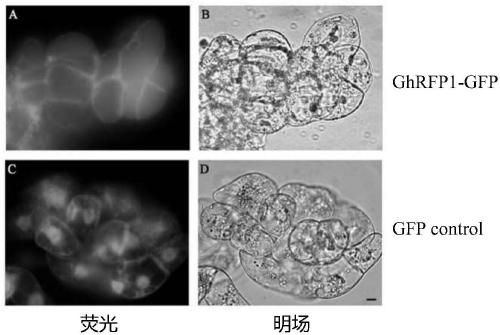GhRFP1 gene and recombinant vector thereof
A recombinant vector and gene technology, applied in genetic engineering, plant gene improvement, recombinant DNA technology, etc., can solve the problems of poor understanding of the function of RING protein, etc., and achieve the effect of increased fiber length and high expression level
- Summary
- Abstract
- Description
- Claims
- Application Information
AI Technical Summary
Problems solved by technology
Method used
Image
Examples
Embodiment 1
[0015] 1. Cotton GhRFP1 gene
[0016] A cDNA encoding the RING protein family gene was isolated from the fiber of upland cotton R15 (Gossypium hirsutum, Cotton Research Institute, Shanxi Academy of Agricultural Sciences) in the elongation period 12 days after flowering (12DPA), and the gene was named GhRFP1. The base sequence is as described in SEQ ID NO.1, the gene open reading frame (ORF) is the 68th to 667th nucleotides from the 5' end of sequence 1 in the sequence listing, the gene code is named GhRFP1, the amino acid sequence of the gene As described in SEQ ID NO.2, the sequence 2 in the sequence listing consists of 199 amino acids.
[0017] 2. Expression analysis of GhRFP1 gene
[0018] RNA was extracted from different cotton tissues and organs (roots, stems, leaves, flowers) and cotton fibers of different days of development, cDNA was obtained by reverse transcription, and the 3' end and 3' untranslated region sequence of the ORF of GhRFP1 were used as primers (upstrea...
Embodiment 2
[0020] Analysis of subcellular localization of GhRFP1: RNA extraction from upland cotton R15 fibers and reverse transcription. Using cDNA as a template, 5'-CGGGATCCATGGCAACCCCTCCCCTTTCAT-3' as an upstream primer and 5'-CGAGCTCAGCCAAAAGTCACCACCACCCTC-3' as a downstream primer', a 612bp PCR product (through sequencing, sequence 1 with sequence listing from 5' end 68 to 667 nucleotides).
[0021] Construction of pPZP-GFP-GhRFP1: Digest the above 612bp PCR product with BamH I and Sac I, and connect the resulting restriction product to the pPZP-GFP vector that has undergone the same digestion (the GhRFP1 fragment is inserted into the 8th and 16th bases of the vector between the bases, the carrier has a complete GFP ORF nucleotide fragment), and the recombinant vector pPZP-GFP-GhRFP1 is obtained. The vector inserts the 68th to 667th nucleotides from the 5' end of sequence 1 in the sequence listing into pPZP- The vector obtained from the BamH I and Sac I restriction sites of the GFP...
Embodiment 3
[0025] Construction and functional identification of GhRFP1 plant expression vector
[0026] 1. Construction of recombinant plant expression vector
[0027] Construction of pCanG-GhRFP1: Digest the above PCR product with BamH I and Sac I, and connect the resulting digested product to the pCanG-HA vector that has undergone the same digestion to obtain the recombinant vector pPZP-GhRFP1, which is the sequence in the sequence listing 1 The vector obtained by inserting the nucleotides 68 to 667 of the 5' end into the BamH I and Sac I restriction sites of the pCanG-HA vector.
[0028] 2. Acquisition and identification of transgenic cotton
[0029] The recombinant plasmid pCanG-GhRFP1 was introduced into Agrobacterium EHA105 to obtain the recombinant strain pCanG-GhRFP1 / EHA105. The lateral roots of aseptic seedlings of upland cotton R15 were used as explants to co-culture with Agrobacterium pCanG-GhRFP1 / EHA105. After callus culture and differentiation, T0 generation cotton seedlin...
PUM
 Login to View More
Login to View More Abstract
Description
Claims
Application Information
 Login to View More
Login to View More - R&D
- Intellectual Property
- Life Sciences
- Materials
- Tech Scout
- Unparalleled Data Quality
- Higher Quality Content
- 60% Fewer Hallucinations
Browse by: Latest US Patents, China's latest patents, Technical Efficacy Thesaurus, Application Domain, Technology Topic, Popular Technical Reports.
© 2025 PatSnap. All rights reserved.Legal|Privacy policy|Modern Slavery Act Transparency Statement|Sitemap|About US| Contact US: help@patsnap.com


